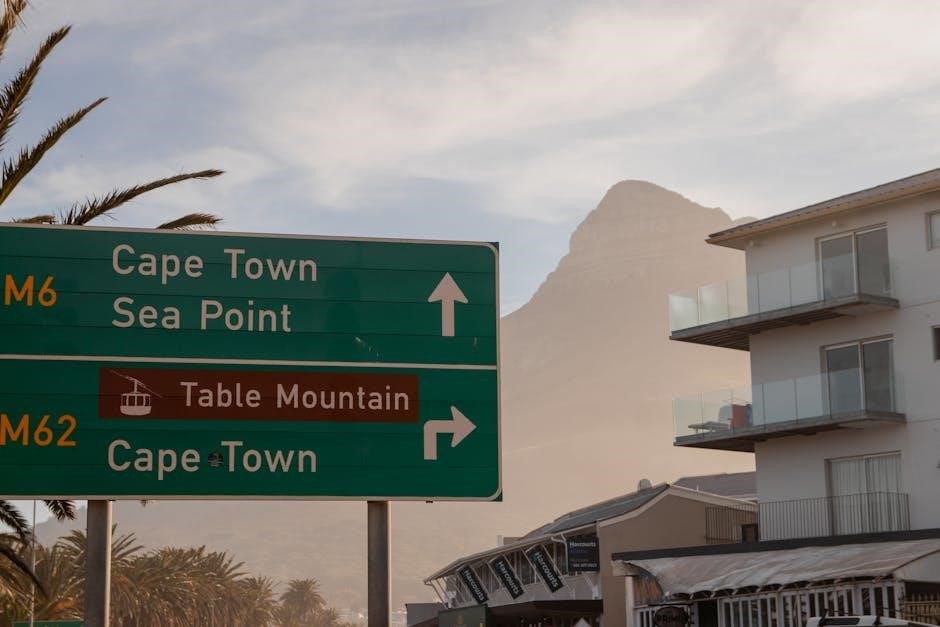tristan gooley the walker’s guide to outdoor clues and signs
Tristan Gooley, an award-winning author, is renowned for his expertise in natural navigation and outdoor awareness․ His book, The Walker’s Guide to Outdoor Clues and Signs, reveals how to interpret nature’s signals for navigation, weather prediction, and survival․ This comprehensive guide empowers readers to reconnect with the natural world, offering practical insights for outdoor enthusiasts and nature lovers alike․
Overview of “The Walker’s Guide to Outdoor Clues and Signs”
Tristan Gooley’s The Walker’s Guide to Outdoor Clues and Signs is a groundbreaking guide that unlocks the secrets of natural navigation and outdoor awareness․ This comprehensive book teaches readers how to interpret signs in nature, such as landforms, celestial patterns, and animal behavior, to navigate effectively․ It also covers weather prediction, survival skills, and the art of observing vegetation and water sources․ By combining practical techniques with scientific insights, Gooley empowers walkers and outdoor enthusiasts to deepen their connection with the natural world․ The book is both a practical manual and an inspiring exploration of the interconnectedness of nature, making it an essential resource for anyone venturing into the wild․
Tristan Gooley’s Background and Expertise
Tristan Gooley is an internationally recognized author, natural navigator, and outdoor educator with a deep passion for connecting people with nature․ His expertise spans decades of hands-on experience in wilderness survival, navigation, and environmental education․ Gooley’s work is rooted in rigorous research and practical application, allowing him to distill complex natural phenomena into accessible, user-friendly techniques․ He has written several bestselling books, including The Walker’s Guide to Outdoor Clues and Signs, which has been praised for its clarity and depth․ Gooley’s unique ability to blend scientific knowledge with real-world examples has established him as a leading authority in the field of natural navigation and outdoor awareness․

Understanding Natural Navigation
Natural navigation involves using the environment to find direction, relying on the sun, moon, stars, landforms, and vegetation patterns to uncover hidden clues for navigation and survival․
The Importance of Observing Landforms and Terrain
Observing landforms and terrain is crucial for natural navigation, as they provide clear directional clues․ Ridged hills, valleys, and slopes often align with compass directions, helping walkers orient themselves․ Erosion patterns and water flow typically follow a southerly direction in the northern hemisphere, offering subtle indicators․ Even subtle features like the shape of hills can reveal compass directions․ By studying these natural formations, walkers can decipher the landscape’s hidden navigation system․ Gooley emphasizes how terrain shapes are consistent and predictable, making them reliable tools for navigation․ This skill enhances outdoor awareness and fosters a deeper connection with the environment, proving indispensable for adventurers and nature enthusiasts alike․
Using the Sun, Moon, and Stars for Orientation
The sun, moon, and stars are timeless tools for navigation․ The sun’s movement reveals direction, with shadows indicating south in the northern hemisphere․ The moon’s phases and brightness can also guide orientation․ Stars like the North Star provide consistent directional cues․ Gooley explains how to use these celestial bodies effectively, even in challenging conditions․ By observing their positions and patterns, walkers can navigate confidently without modern tools․ This ancient yet reliable method connects adventurers to the natural world, offering a profound sense of place and direction․ Mastering these techniques enhances outdoor journeys, proving that nature’s light can always illuminate the way․

Reading Signs in Nature
Reading signs in nature involves recognizing patterns in the environment, from landforms to vegetation, helping walkers navigate and understand their surroundings more deeply․
Identifying Animal Tracks and Their Meanings
Identifying animal tracks is a key skill in natural navigation, offering insights into the behavior and movement of wildlife․ By studying the shape, size, and pattern of tracks, walkers can determine the type of animal, its direction, and even its urgency or caution․ For instance, the spacing and depth of tracks reveal whether an animal is running or walking․ Tristan Gooley highlights how tracks can also indicate the health and mood of an animal, providing a deeper understanding of the ecosystem․ This skill not only enhances navigation but also fosters a stronger connection with nature, making every walk a journey of discovery and observation․
Recognizing Patterns in Trees, Plants, and Vegetation
Recognizing patterns in trees, plants, and vegetation is a fundamental aspect of natural navigation․ Tristan Gooley explains how the growth habits of plants can indicate direction, water sources, and even soil composition․ For example, the north side of tree trunks often shows lighter moss growth due to less sunlight, while certain plants thrive in water-rich areas․ By observing leaf orientations, bark textures, and the clustering of vegetation, walkers can gather valuable clues about their surroundings․ These patterns not only aid in navigation but also reveal the intricate relationships within ecosystems, enriching the outdoor experience with deeper understanding and appreciation of nature’s subtle signals․

Weather Prediction for Walkers
Tristan Gooley’s guide teaches walkers to predict weather by observing cloud formations, wind patterns, and temperature changes, enhancing safety and outdoor planning through natural observations․
Interpreting Cloud Formations and Sky Conditions
Tristan Gooley emphasizes the importance of interpreting cloud formations and sky conditions for weather prediction․ By observing shapes, colors, and altitudes of clouds, walkers can anticipate changes․ Cumulus clouds often signal fair weather, while towering cumulonimbus clouds may indicate storms․ Gooley highlights how cloud movements and wind direction correlate, offering clues about incoming weather systems․ Additionally, changes in sky color, such as orange or red hues at sunrise or sunset, can indicate high pressure or approaching storms․ These natural signs provide reliable tools for walkers to stay informed and prepared in the outdoors, ensuring safer and more enjoyable journeys․
Understanding Wind Patterns and Their Implications
Tristan Gooley explains how wind patterns are crucial for predicting weather and navigating outdoors․ Wind direction often indicates the movement of weather systems, with winds shifting before storms․ Gooley notes that winds blowing against the sun’s direction may signal low pressure․ He also discusses how wind affects vegetation and water, creating visible signs like bent trees or ripples on ponds․ By recognizing these patterns, walkers can better anticipate weather changes and use wind as a natural compass․ Such observations enhance outdoor awareness, making walkers more attuned to their environment and better equipped to handle varying conditions during their journeys․

Animal Behavior and Outdoor Clues
Tristan Gooley reveals how animal behavior signals weather changes and navigation cues․ Birds flying low, insects swarming, and animals seeking shelter indicate impending storms or calm skies, aiding walkers in tracking environmental shifts and making informed decisions․
How Birds and Insects Indicate Weather Changes
Birds and insects play a crucial role in signaling weather changes, offering subtle yet reliable clues for outdoor enthusiasts․ According to Tristan Gooley, birds flying low to the ground often indicate impending bad weather, as they seek shelter from strong winds or rain․ Similarly, the sudden disappearance of birdsong or unusual silence among birds can signal an approaching storm․ Insects, too, provide valuable insights; swarming behavior or a sudden drop in activity may predict weather shifts․ By observing these patterns, walkers can anticipate changes in conditions, aiding in navigation and decision-making․ Such natural cues highlight the interconnectedness of wildlife and weather, offering practical tools for those attuned to nature’s signals․
Deciphering the Role of Domestic and Wild Animals
Domestic and wild animals provide invaluable clues for outdoor navigation and weather prediction, as highlighted in Tristan Gooley’s work․ Domestic animals, such as cattle and sheep, often align their bodies with the direction of the wind, while birds and squirrels may indicate weather changes through their behavior․ Wild animals, like deer and rabbits, reveal habitat preferences tied to terrain and water sources․ By observing grazing patterns, nesting behaviors, and migration routes, walkers can gain insights into their surroundings․ These natural indicators not only enhance navigation skills but also deepen the understanding of ecosystems, showcasing the interconnectedness of life and landscape․ Gooley’s approach emphasizes the practicality of animal behavior for outdoor enthusiasts, offering a bridge between nature and human survival instincts․

Advanced Outdoor Skills

Tristan Gooley’s advanced outdoor skills involve mastering complex natural navigation techniques, combining observation of landforms, celestial bodies, and animal behavior for precise and reliable guidance in wilderness environments․
Mastery of Natural Navigation Techniques
Mastery of natural navigation techniques, as explored by Tristan Gooley, involves a deep understanding of the natural world․ By observing the sun, moon, stars, and landforms, one can develop precise navigational skills․ Gooley emphasizes the importance of recognizing patterns in nature, such as the alignment of hills, the direction of tree growth, and the behavior of animals․ These techniques, honed over centuries, allow individuals to navigate without modern tools․ The ability to predict weather changes and locate essential resources like water and shelter is also central to this skill set․ With practice, anyone can become proficient in reading nature’s signs, making outdoor exploration safer and more rewarding․
Combining Multiple Clues for Reliable Navigation
Tristan Gooley emphasizes the importance of combining multiple natural clues for accurate navigation․ By integrating observations of landforms, vegetation patterns, animal behavior, and celestial alignments, one can achieve a high level of reliability․ For example, aligning the position of the sun with terrain features or cross-referencing animal tracks with wind patterns enhances navigational precision․ This holistic approach minimizes reliance on a single clue, reducing the risk of error․ Gooley’s techniques encourage observers to synthesize diverse natural indicators, fostering a deeper connection with the environment and improving situational awareness․ This method is particularly valuable in wilderness settings, where modern tools may be unavailable or unreliable․

Modern Tools and Traditional Methods
Tristan Gooley’s work bridges modern tools like GPS and compasses with timeless natural navigation techniques․ He advocates for integrating technology with traditional skills to enhance outdoor awareness and reliability․
Using GPS and Compasses Effectively
Tristan Gooley emphasizes the importance of combining modern tools like GPS and compasses with natural navigation skills․ While GPS provides precise location data, it should complement, not replace, observing natural signs․ Gooley offers practical tips for using these tools effectively, such as marking waypoints and understanding compass features․ He also highlights the need to balance reliance on technology with traditional methods, ensuring users remain aware of their surroundings․ By integrating GPS and compasses into a broader skill set, walkers can enhance their navigation accuracy and build resilience against device failures or challenging conditions․
Integrating Traditional Knowledge with Modern Technology
Tristan Gooley advocates for blending traditional natural navigation techniques with modern technology to enhance outdoor experiences․ He suggests using apps and GPS alongside observations of nature, such as the sun’s position or tree patterns․ This hybrid approach ensures accuracy and builds redundancy․ Gooley emphasizes that technology should aid, not replace, natural awareness, fostering a deeper connection with the environment․ By combining old and new methods, walkers can navigate more effectively and appreciate the interconnectedness of natural and technological tools, creating a more robust and enjoyable outdoor navigation system․

Survival Skills from Nature
Tristan Gooley’s work highlights nature’s ability to provide essential resources for survival․ By identifying water sources, locating food through plant signs, and using terrain for shelter, walkers can thrive outdoors․
Finding Water Sources Using Outdoor Signs
Tristan Gooley’s guide reveals how to identify water sources by observing natural indicators․ Animal tracks often converge near water, while lush vegetation and specific plant species thrive in moist areas․ Depressions in terrain, such as valleys or dips, commonly collect water․ Bird activity, like flying in a specific direction, can signal nearby water․ Insects, especially those attracted to moisture, also provide clues․ At night, the sounds of frogs or crickets may indicate water nearby․ By combining these signs, walkers can locate water effectively, even in unfamiliar landscapes, ensuring survival in the wilderness․
Locating Food and Shelter Through Natural Indicators
Tristan Gooley’s guide teaches how to identify food and shelter using natural signs․ Animal tracks and bird behavior often reveal edible plants or small game․ Specific tree formations, like knots or hollows, may indicate insect nests or stored food․ Shelter can be found in natural features such as caves, rock overhangs, or hollowed tree trunks․ Vegetation patterns, like dense shrubs or evergreen trees, may signal protected areas․ By observing terrain contours and animal movements, walkers can locate resources efficiently, ensuring survival in the wild․ Gooley’s methods highlight how nature provides subtle yet reliable clues for sustenance and refuge, empowering adventurers to thrive outdoors․
Tristan Gooley’s work revolutionizes outdoor navigation, empowering readers to decode nature’s clues for survival and exploration․ His insights bridge tradition and modernity, fostering a deeper connection with the natural world․
Applying Tristan Gooley’s Methods in Everyday Life

Tristan Gooley’s techniques offer practical tools for enhancing outdoor experiences and daily life․ By observing nature, individuals can improve navigation, predict weather, and develop a deeper connection with their surroundings․ His methods, such as reading landforms and tracking animal behavior, empower people to make informed decisions while hiking, camping, or simply exploring urban environments․ Beyond survival, these skills foster mindfulness, encouraging a greater appreciation for the natural world․ Gooley’s insights are applicable to anyone seeking to reconnect with nature, whether in remote wilderness or local parks․ His work bridges the gap between traditional knowledge and modern life, proving that nature’s clues are timeless and universally useful․
The Future of Outdoor Navigation and Nature Awareness
The future of outdoor navigation and nature awareness lies in blending traditional techniques with modern innovations․ Tristan Gooley’s work highlights the enduring relevance of natural navigation, encouraging a new generation to embrace these timeless skills․ As technology advances, integrating traditional knowledge with digital tools will create more accessible and versatile navigation systems․ Education and community efforts will play a key role in preserving and promoting nature awareness․ By fostering a deeper connection with the environment, Gooley’s methods inspire a global movement toward mindful exploration and sustainable interaction with the natural world․ This harmonious blend of old and new ensures that outdoor navigation remains both practical and enriching for years to come․
